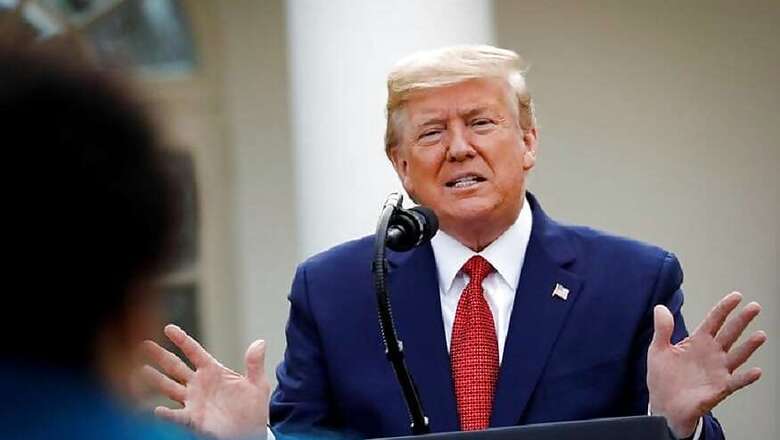
views
President Donald Trump said he’s open to some states “reopening” before federal social distancing guidelines expire at the end of month as he appeared to back off his claim of absolute authority to decide when the time was right to act.
Hours after suggesting that the bipartisan concerns of governors about his assertion of power would amount to an insurrection, Trump abruptly reversed course Tuesday, saying he would leave it to governors to determine when and how to revive activity in their states. He said he likely would discuss his plans with governors on Thursday.
“The governors are responsible," Trump said. “They have to take charge.”
Still, he insisted, “The governors will be very, very respectful of the presidency."
Democratic and Republican governors had objected after Trump asserted Monday that he alone would determine when and how to reopen the economy, despite clear constitutional limitations on federal powers.
Trump said Tuesday he would authorize governors "of each individual state to implement a reopening — and a very powerful reopening — plan of their state at a time and in a matter as most appropriate.” Trump added that he would support moves by states that haven't been hit hard by the outbreak to ease restrictions even before federal guidelines on social distancing expire April 30.
Trump said the country would open up “in beautiful little pieces,” adding that some states with low rates of infection ”have fewer people and they have lots of room."
It’s unclear if any states are actively considering reopening their economies before May 1.
In a departure from recent tradition, Trump ended his daily briefing without turning the mic over to federal health experts, who have cautioned against moving too quickly to restart economic activity.
Dr. Anthony Fauci, the nation’s top infectious diseases expert, told The Associated Press earlier Tuesday that the country is “not there yet” when it comes to the kind of testing and tracing needed for the economy to reopen. But Trump made clear Tuesday he is intent on proceeding with his plans.
Trump outlined a vision in which workers would be tested, perhaps weekly, and governors would test travelers arriving at their states’ borders. But the U.S. is nowhere near having that kind of infrastructure, with testing still largely reserved for those with serious symptoms and results taking days to learn.
The Centers for Disease Control and Prevention has been working with other federal officials to develop detailed plans for how reopening should occur, including determining what measures will need to be tracked and what conditions met before such steps occur. The plans include separate steps for schools, businesses and other entities, the CDC’s Dr. Anne Schuchat said. The proposals are currently under review, she added.
Kellyanne Conway, a top adviser to Trump, told reporters Wednesday that about 29 states “feel that they, perhaps, could come back online a little bit more robustly. It’s not going to be turning a spigot everywhere immediately.” She said Trump isn't looking at a certain date. ”He's looking at data."
House Speaker Nancy Pelosi criticized Trump for trying to lift social distancing without adequate testing. “The failure to test is dangerous and deadly, and without testing, we cannot resume our lives,” she said in a letter to lawmakers.
In expressing an openness to states setting their own timelines, Trump was largely acknowledging the authority governors have already exercised.
While Trump has issued national recommendations advising people to stay home, governors and local leaders are the ones who ordered schools and nonessential business to close.
After weeks of saying he would leave major decisions about imposing such restrictions to the states, Trump claimed his power to ease them was absolute.
“When somebody is president of the United States, the authority is total,” Trump said Monday at the White House. “The governors know that.” He declined to state the source of his asserted power, claiming he would provide a legal briefing at a later date.
But governors in both parties made clear they saw things differently and said they would decide when to return to normal just as they decided to close things down.
“The president’s position is just absurd,” New York Democratic Gov. Andrew Cuomo said Tuesday on “CBS This Morning.”
Arkansas Gov. Asa Hutchinson, a Republican, said he, would do what is "in the best interest of Arkansans and I think that’s what the people expect.”
Anxious to put the crisis behind him, Trump launched a new advisory council that will hash out plans to reopen the economy, which has dramatically contracted as businesses have shuttered, leaving millions of people out of work.
He also directed his administration to freeze funding to the World Health Organization, claiming the international body didn’t deliver adequate early reports on the virus and cost the U.S. valuable response time.
Earlier Tuesday, Trump initially indicated he was relishing the fight with state officials — particularly Democrats in hard-hit states — who have voiced fears that the president’s ambitious timetable could lead to a resurgence of a virus that is still killing more than 1,000 Americans a day.
“A good old fashioned mutiny every now and then is an exciting and invigorating thing to watch, especially when the mutineers need so much from the Captain,” Trump tweeted, adding, “Too easy!”
Trump began to soften his approach later in the day as he met with people who have recovered from COVID-19, including former pro football player Mark Campbell and Karen Whitsett, a member of the Michigan House.
Still, Trump warned that he will monitor how the governors perform and signaled he might blame them if he believes their actions slow the pace of what he hopes will be a robust economic recovery.
“If they don’t do a good job we’re going to come down on them hard," Trump said.




















Comments
0 comment